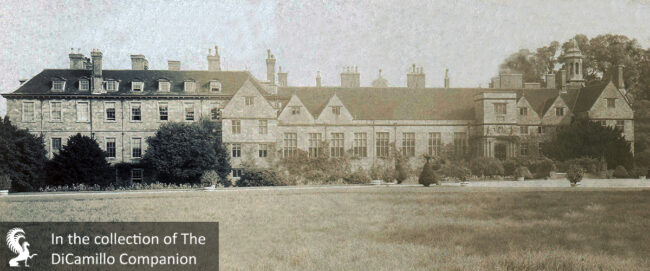
The West Facade from a circa 1910 postcard
House & Family History: Rufford Abbey was founded by Gilbert de Grant in 1146 as a Cistercian monastery and was once one of the great estates of Sherwood Forest. In 1536 the abbey was dissolved by Henry VIII and its lands granted to George Talbot, 4th Earl of Shrewsbury. The Talbots began the transformation of the buildings from abbey to country house, incorporating elements of the former abbey into their house, including what is today the best-preserved remains of a Cistercian abbey west cloister range in England. In 1626 Rufford Abbey passed to the Savile family, in whose ownership it remained until 1938. In the 18th century Sir George Savile rebuilt the House and landscaped the gardens, making it his country seat. Byng, in 1789, called Rufford "gloomy and ill-managed" and "very melancholy." In 1931, following the death of the 2nd Lord Savile, the Estate was sold and, in 1938, the doors of Rufford closed. In 1952 Nottinghamshire County Council purchased Rufford for use as a public park, which it remains today. The badly damaged 18th century north and east wings were completely demolished in 1959 and the remains of the house, parts of which are ruinous, was put in the care of English Heritage. The Jacobean wing, which formed the kitchen and servant quarters, was restored in 1997 and now houses the Savile Restaurant. The cloisters, with undercroft, are very similar in arrangement to those at Fountains Abbey. The lay-brothers' frater is one of the best-preserved in England.
Garden & Outbuildings: Today's 150-acre public park includes gardens that were re-established in the late 1970s on the site of the former water and oriental gardens. The former Stableblock today houses a contemporary ceramic gallery and craft center. There is a fine Gardener's Cottage, probably by Salvin, and a late Victorian Coach House, Brewhouse, and a Water Tower, all in a red brick Jacobethan style. The Orangery of 1889 was built around the existing Bath Summer House of 1729 by John Hallam. Rufford Abbey was the subject of a Heritage Lottery bid in 2002 to reveal more of what experts believe to be one of the most complete country estate landscapes in England.
Architect: Anthony Salvin
Date: 1838-40Country Life: XIV, 650, 1903.
Title: Buildings of England: Nottinghamshire, The
Author: Pevsner, Nikolaus; Williamson, Elizabeth (Revised)
Year Published: 1979
Publisher: London: Penguin Books
ISBN: 0140710027
Book Type: Hardback
House Listed: Grade I
Park Listed: Grade II
Past Seat / Home of: George Talbot, 4th Earl of Shrewsbury, 16th century. Sir George Savile, 8th Bt., until 1784; John Savile, 1st Baron Savile, until 1896; John Savile Lumley-Savile, 2nd Baron Savile, 1896-1931; Savile family here from 1626 until 1938.
Current Ownership Type: Government
Primary Current Ownership Use: Visitor Attraction
Ownership Details: Owned by Nottinghamshire County Council and managed by Parkwood Outdoors in cooperation with English Heritage.
House Open to Public: Yes
Phone: 01623-822-944
Website: https://www.english-heritage.org.uk
Historic Houses Member: No